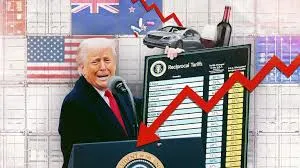Explore how former President Donald Trump tariffs affected the stock market, with an in-depth analysis of stock price fluctuations, trade tensions, and global economic consequences.
The Impact of Donald Trump Tariffs on the Stock Market
When Donald Trump assumed office in 2017, one of his most prominent economic strategies was the introduction of tariffs, particularly targeting China. His “America First” policy aimed to reduce the trade deficit and bring manufacturing jobs back to the United States. However, these tariffs created a ripple effect across global markets, raising questions about their long-term impact on the stock market and the economy. In this article, we’ll examine how Trump’s tariff policies influenced stock prices, trade relations, and market volatility.

A Shift in Global Trade Dynamics
During Trump’s presidency, the United States imposed tariffs on billions of dollars’ worth of Chinese goods. The administration argued that these tariffs were necessary to address unfair trade practices, intellectual property theft, and the growing trade imbalance between the two nations. While the move was initially hailed by some as a bold stance to protect U.S. industries, it also set off a chain of reactions that would significantly affect stock markets.
The tariffs led to a rise in uncertainty in the global trade system. With trade tensions escalating, global companies—especially those reliant on Chinese imports—faced increased production costs. This prompted fears of slower economic growth, which, in turn, impacted stock prices.
Immediate Effects on the Stock Market
The imposition of tariffs resulted in immediate volatility in the stock market. After Trump announced his tariff policy in 2018, major stock indices, including the S&P 500 and the Dow Jones Industrial Average, experienced sharp fluctuations. In particular, stocks of companies in industries heavily dependent on global supply chains, such as technology and manufacturing, saw significant declines.
The tech sector, in particular, was hit hard. U.S.-based companies that sourced products or components from China found themselves grappling with higher import costs. For example, Apple, one of the largest technology companies in the world, saw its stock drop as a result of tariff fears. Similarly, companies in the automotive sector, such as Ford and General Motors, experienced stock market declines due to higher costs for importing parts and materials from China.
Long-Term Effects on Stock Prices
While the initial impact of the tariffs was negative, the stock market did begin to show signs of recovery over time. A key reason for this recovery was the ongoing negotiations between the U.S. and China, leading to a phase-one trade deal in January 2020. The deal eased some of the tensions and offered a glimmer of hope to investors who feared the tariffs would escalate into a full-blown trade war.
However, many experts argue that the long-term consequences of the tariffs were more complex. The trade war’s aftermath resulted in shifts in global supply chains. For example, companies began looking to diversify their manufacturing operations away from China to mitigate tariff risks. This led to increased investment in other regions, including Southeast Asia, Mexico, and even the U.S. itself.
Despite this shift, many industries continued to face price hikes on imported goods, which further contributed to inflationary pressures. This, in turn, affected consumer spending and corporate profits, causing a ripple effect on stock prices.

A Broader Economic Impact
Beyond individual companies, Trump’s tariffs affected the broader U.S. economy and the global marketplace. Higher costs on imported goods led to inflationary pressures, which prompted the Federal Reserve to adjust interest rates. As the central bank lowered rates to stimulate the economy, it created a situation of financial instability that sometimes resulted in erratic stock market movements.
Additionally, the trade war with China also led to a slowdown in global growth. Many international businesses that relied on the U.S. as a key trading partner felt the effects, causing stock market volatility around the world. Emerging markets, which were already struggling with their own economic issues, were further strained by the uncertainty surrounding the U.S.-China trade relationship.
Final Thoughts on Trump’s Tariffs and Stock Market Volatility
The legacy of Donald Trump’s tariffs on the stock market remains mixed. On one hand, some investors saw opportunities in sectors like steel production and domestic manufacturing, which benefited from the tariffs. On the other hand, the broader stock market faced increased volatility as companies navigated higher costs and potential trade disruptions.
In the long run, the stock market showed resilience, recovering from initial drops and continuing to grow as the U.S. economy adapted to the new trade realities. However, it is clear that tariffs played a role in reshaping trade dynamics, influencing investor sentiment, and affecting stock market performance.
As we move forward, the lessons learned from Trump’s tariff policies could inform future trade decisions and market reactions. Investors and policymakers alike will need to weigh the costs and benefits of protectionist measures in an increasingly interconnected global economy.




